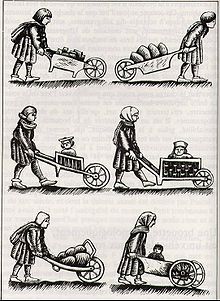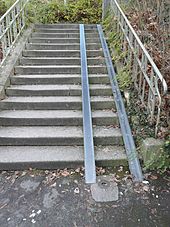stroller


The stroller is a means of transport with which babies and toddlers are transported lying down or sitting.
history
In medieval Europe , the wheelbarrows introduced here between 1170 and 1250 were used to transport children.
According to sources, around the middle of the 16th century, a carpenter first built a transport cart that was intended for his one-year-old child. Before that, the children were carried around in towels, baskets and wooden sacks, some of which were strapped to pack animals, or they were transported in the wheelbarrows mentioned above. Before 1800 the small wagons were only used very occasionally to carry children. The children had to sit and were pulled by dogs or goats. The better the streets got, the more wagon-like carts were used, which were made to order by a few carpenters.
The stroller for the street evolved from the bassinet , a wheeled child's basket that was used inside the home. It was invented in Great Britain , where it became common in the early 19th century to take small children for daily walks . In 1840 the first factory for prams was founded in England. The first models were very tall and had three wheels; they were designed so that the babies could only sit in them. These cars were therefore not suitable for the first few months of life. A few years later the new vehicle was introduced at the English royal court. In 1855 an observer noted: “The streets of London are full of baby carriages that were previously unknown to me and in which babies are pushed instead of pulled by their nannies.” In 1880 the first models were constructed in which the infant could lie. The attachment consisted of a wicker basket, the frame now had four wheels.
In the middle of the 19th century, the wheelwright Ernst Albert Naether founded a company for the production of prams in Zeitz , which was converted into the state-owned Zekiwa company during the GDR era . The largest German manufacturer of prams in the period before 1945 was the Brandenburg company "Brennabor", which emerged in 1871 from a basket-making business. After dismantling and expropriation, the company existed for a few years as VEB Brandenburger Kinderwagen and was then incorporated into the Zeitzer Kinderwagenkombinat.
The development of prams in the 20th century was heavily influenced by the automotive industry . The prams of the 1950s, for example, often had decorative strips and curved fenders . The frame had been made of steel since the 1920s and the wheels were much smaller than before.
Types of strollers
The following typical variants of strollers can be distinguished.
Classic stroller
The classic stroller consists of a basket or a detachable carrier bag and a chassis. It is intended for transporting babies lying down . Today they are also known under the term first car. Small children should have 35 × 78 cm space available in the stroller.
Sports car
Sports strollers are open at the front and have a footrest. At the back they often have a folding hood and the seat back can usually be adjusted. The pushchair is intended for the seated transport of babies and toddlers between the ages of one and two years. Around 2000, three-wheeled sports cars that were equipped with larger wheels were supposed to enable jogging with strollers. This variant of the sports car is therefore also known as a jogger .
Combination stroller
Since a classic stroller can only be used for a short time, the combi stroller was developed. It can be converted from a classic stroller into a sports car. There are now child transport systems that can be used as prams, buggies and bicycle trailers .
buggy
The buggy is widespread today as a compact, foldable sports car. Buggies are much more manageable, light and very manoeuvrable thanks to their steerable front wheels. This type of stroller was developed in 1965 by the English aircraft designer Owen Maclaren, who died in 1978 . This new model was made of aluminum and, unlike the previous strollers, could be folded up. Production at Maclaren started in 1967. The great success of these buggies meant that other manufacturers brought their own products onto the market. Because of their small wheels, buggies are only suitable for paved paths and shorter distances.
Special strollers
Strollers of various designs are available for transporting several children. The seating or lying surfaces are arranged next to or behind one another. Special strollers are also available for small children due to hip dysplasia , a spreader must wear. These spreading strollers must have a wider lying surface in the hip area. It is an expandable attachment. The appropriate width can be set for children with spreader pants, plaster of paris or splints.
Crib wagon
The original crib wagon is intended for the transport of up to six toddlers between the ages of one and three years. It was used by day nurseries in the GDR. It is particularly suitable for making larger trips with small children. In the meantime, child minders and day-care centers in West Germany have also discovered him. Today there is a wide range of different crib carriages, including those that have space for 10 children. Modern crib wagons often deviate from the classic shape. They have been adapted to the ergonomic needs of the child carers and equipped with belts and other safety-related details. Other extras include sun protection and an electric motor. As a rule, cribs are certified in accordance with the EN 1888 safety standard or the American ASTM guidelines.
Rehab buggy and rehab stroller
Various types of strollers are available for transporting children with disabilities. These differ from conventional strollers in that they have a higher load capacity and better adaptability. Due to their folding technology, rehab buggies are usually easier to transport than rehab strollers. In return, rehab vehicles usually offer better driving comfort.
Pushchair with pedal function
The skateboarding-oriented strollers can be expanded to a scooter or longboard by integrating a stand board . They allow the driver to use the stroller like a scooter and steer it by shifting weight. Depending on the model, the pushchairs with pedal function are equipped with a hand or foot brake. Speeds of up to 15 km / h can be achieved. The first pushchair with a pedal function, called a Roller Buggy , was developed in 2005 by product designer Valentin Vodev. Furthermore, the stroller manufacturer Quinny was interested in the idea and commissioned a Dutch design studio with the experimental development of a stroller with a pedal function.
Belt systems
Strollers can either have integrated belt systems to prevent them from climbing out, or attachment points to which a separate child safety belt can be attached. Integrated systems are often designed as 5-point belts, with the crotch belt preventing them from slipping downwards.
literature
-
The stroller . In: Stephen van Dulken: The great book of inventions. Ideas that made history. Translated by Andreas Venzke (Original title: Inventing the 19th Century. The Great Age of Victorian Inventions ), Artemis and Winkler , Düsseldorf / Zurich 2005, ISBN 978-3-538-07187-2 , p. 31f
Paperback edition: insel taschenbuch 3236, Frankfurt am Main / Leipzig 2006, ISBN 978-3-458-34936-5 - Béatrice Fontanel, Claire D'Harcourt: Babies in the Cultures of the World. Translated by Cornelia Panzacchi and Andrea Unseld (original title: Bèbès du monde ), Gerstenberg, Hildesheim 2007. ISBN 978-3-8369-2957-8 .
- Heinz Sturm-Godramstein: Strollers yesterday and today. Extended and updated new edition, Book on Demand , Norderstedt 2001, ISBN 3-8311-2212-1
Web links
Sources and individual references
- ↑ The history of the stroller. Retrieved April 13, 2015 .
- ↑ Béatrice Fontanel / Claire d'Harcourt, baby, infant, diaper. Eine Kulturgeschichte, Hildesheim 1998, p. 184 ff.
- ↑ Strollers: Only one stroller convinced in the test - (Stiftung Warentest; In: test.de from February 3, 2015)
- ↑ Spread stroller. (No longer available online.) Formerly in the original ; accessed on April 13, 2015 . ( Page no longer available , search in web archives ) Info: The link was automatically marked as defective. Please check the link according to the instructions and then remove this notice.
- ↑ Catherine Osborne: "Scoot'n Stroll", Azure, Toronto, Azure Publishing, October 2007, p. 46, ISSN 0829-982X
- ↑ Greg Allen, "The Longboard Stroller, AKA The Quinny Jett Concept Daddytypes," June 1, 2013.
- ↑ The stroller belt: suspender belt or 5-point belt? . Bonavi. February 17, 2017. Retrieved June 13, 2019.









